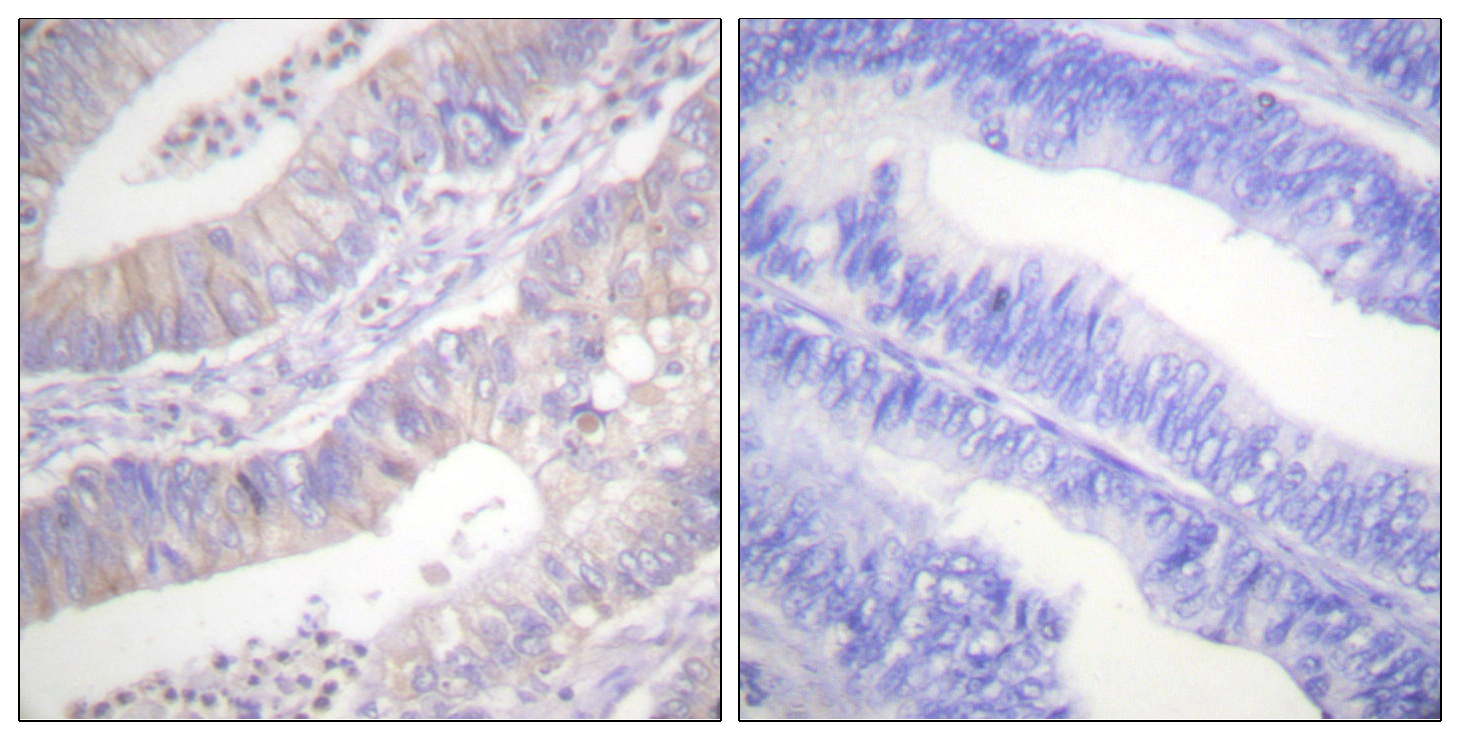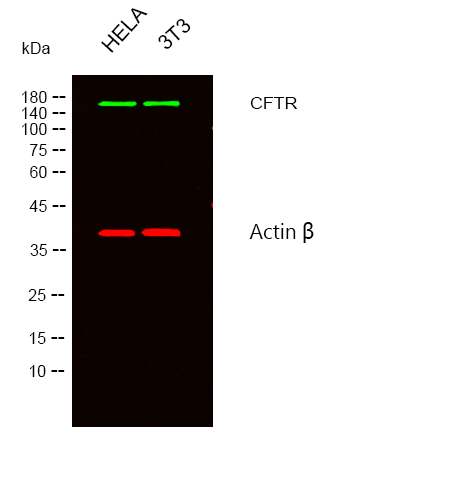CFTR Polyclonal Antibody
- Catalog No.:YT0888
- Applications:WB;IHC;IF;ELISA
- Reactivity:Human;Mouse;Rat
- Target:
- CFTR
- Fields:
- >>ABC transporters;>>cAMP signaling pathway;>>AMPK signaling pathway;>>Tight junction;>>Gastric acid secretion;>>Pancreatic secretion;>>Bile secretion;>>Vibrio cholerae infection
- Gene Name:
- CFTR
- Protein Name:
- Cystic fibrosis transmembrane conductance regulator
- Human Gene Id:
- 1080
- Human Swiss Prot No:
- P13569
- Mouse Gene Id:
- 12638
- Mouse Swiss Prot No:
- P26361
- Rat Gene Id:
- 24255
- Rat Swiss Prot No:
- P34158
- Immunogen:
- The antiserum was produced against synthesized peptide derived from human CFTR. AA range:711-760
- Specificity:
- CFTR Polyclonal Antibody detects endogenous levels of CFTR protein.
- Formulation:
- Liquid in PBS containing 50% glycerol, 0.5% BSA and 0.02% sodium azide.
- Source:
- Polyclonal, Rabbit,IgG
- Dilution:
- WB 1:500 - 1:2000. IHC 1:100 - 1:300. ELISA: 1:5000.. IF 1:50-200
- Purification:
- The antibody was affinity-purified from rabbit antiserum by affinity-chromatography using epitope-specific immunogen.
- Concentration:
- 1 mg/ml
- Storage Stability:
- -15°C to -25°C/1 year(Do not lower than -25°C)
- Other Name:
- CFTR;ABCC7;Cystic fibrosis transmembrane conductance regulator;CFTR;ATP-binding cassette sub-family C member 7;Channel conductance-controlling ATPase;cAMP-dependent chloride channel
- Observed Band(KD):
- 168kD
- Background:
- This gene encodes a member of the ATP-binding cassette (ABC) transporter superfamily. ABC proteins transport various molecules across extra- and intra-cellular membranes. ABC genes are divided into seven distinct subfamilies (ABC1, MDR/TAP, MRP, ALD, OABP, GCN20, White). This protein is a member of the MRP subfamily that is involved in multi-drug resistance. The encoded protein functions as a chloride channel and controls the regulation of other transport pathways. Mutations in this gene are associated with the autosomal recessive disorders cystic fibrosis and congenital bilateral aplasia of the vas deferens. Alternatively spliced transcript variants have been described, many of which result from mutations in this gene. [provided by RefSeq, Jul 2008],
- Function:
- catalytic activity:ATP + H(2)O = ADP + phosphate.,disease:Defects in CFTR are the cause of congenital bilateral absence of the vas deferens (CBAVD) [MIM:277180]. CBAVD is an important cause of sterility in men and could represent an incomplete form of cystic fibrosis, as the majority of men suffering from cystic fibrosis lack the vas deferens.,disease:Defects in CFTR are the cause of cystic fibrosis (CF) [MIM:219700]; also known as mucoviscidosis. CF is the most common genetic disease in the Caucasian population, with a prevalence of about 1 in 2'000 live births. Inheritance is autosomal recessive. CF is a common generalized disorder of exocrine gland function which impairs clearance of secretions in a variety of organs. It is characterized by the triad of chronic bronchopulmonary disease (with recurrent respiratory infections), pancreatic insufficiency (which leads to malabsorption and
- Subcellular Location:
- Apical cell membrane ; Multi-pass membrane protein . Early endosome membrane ; Multi-pass membrane protein . Cell membrane ; Multi-pass membrane protein . Recycling endosome membrane ; Multi-pass membrane protein . Endoplasmic reticulum membrane ; Multi-pass membrane protein . Nucleus . The channel is internalized from the cell surface into an endosomal recycling compartment, from where it is recycled to the cell membrane (PubMed:17462998, PubMed:19398555, PubMed:20008117). In the oviduct and bronchus, detected on the apical side of epithelial cells, but not associated with cilia (PubMed:22207244). In Sertoli cells, a processed product is detected in the nucleus (By similarity). ER stress induces GORASP2-mediated unconventional (ER/Golgi-independent) trafficking of core-glycosylated CFTR t
- Expression:
- Expressed in the respiratory airway, including bronchial epithelium, and in the female reproductive tract, including oviduct (at protein level) (PubMed:22207244, PubMed:15716351). Detected in pancreatic intercalated ducts in the exocrine tissue, on epithelial cells in intralobular striated ducts in sublingual salivary glands, on apical membranes of crypt cells throughout the small and large intestine, and on the reabsorptive duct in eccrine sweat glands (PubMed:1284548, PubMed:28130590). Detected on the equatorial segment of the sperm head (at protein level) (PubMed:19923167). Detected in nasal and bronchial superficial epithelium (PubMed:15716351). Expressed by the central cells on the sebaceous glands, dermal adipocytes and, at lower levels, by epithelial cells (PubMed:28130590).
- June 19-2018
- WESTERN IMMUNOBLOTTING PROTOCOL
- June 19-2018
- IMMUNOHISTOCHEMISTRY-PARAFFIN PROTOCOL
- June 19-2018
- IMMUNOFLUORESCENCE PROTOCOL
- September 08-2020
- FLOW-CYTOMEYRT-PROTOCOL
- May 20-2022
- Cell-Based ELISA│解您多样本WB检测之困扰
- July 13-2018
- CELL-BASED-ELISA-PROTOCOL-FOR-ACETYL-PROTEIN
- July 13-2018
- CELL-BASED-ELISA-PROTOCOL-FOR-PHOSPHO-PROTEIN
- July 13-2018
- Antibody-FAQs
- Products Images

- Immunohistochemistry analysis of paraffin-embedded human colon carcinoma tissue, using CFTR Antibody. The picture on the right is blocked with the synthesized peptide.

- Western blot analysis of lysates from HELA,3T3 cells, (Green) primary antibody was diluted at 1:1000, 4°over night, secondary antibody was diluted at 1:10000, 37° 1hour. (Red) loading contrl antibody was diluted at 1:5000 as loading control, 4° over night,secondary antibody was diluted at 1:10000, 37° 1hour.



